Abstract
To determine the effect of contraction of the diaphragm on the lower esophageal sphincter (LES) pressure, we studied eight healthy volunteers during spontaneous breathing, maximal inspiration, and graded inspiratory efforts against a closed airway (Muller's maneuver). Electrical activity of the crural diaphragm (DEMG) was recorded from bipolar esophageal electrodes, transdiaphragmatic pressure (Pdi) was calculated as the difference between gastric and esophageal pressures, and LES pressure was recorded using a sleeve device. During spontaneous breathing, phasic inspiratory DEMG was accompanied by phasic increases in Pdi and LES pressure. With maximal inspiration, DEMG increased 15-20-fold compared with spontaneous inspiration, and LES pressure rose from an end-expiratory pressure of 21 to 90 mmHg. Similar values were obtained during maximal Muller's maneuvers. LES pressure fell promptly when the diaphragm relaxed. Graded Muller's maneuver resulted in proportional increases in the Pdi, LES pressure, and DEMG. The LES pressure was always greater than Pdi and correlated with it in a linear fashion (P less than 0.001). We conclude that the contraction of the diaphragm exerts a sphincteric action at the LES, and that this effect is an important component of the antireflux barrier.
Full text
PDF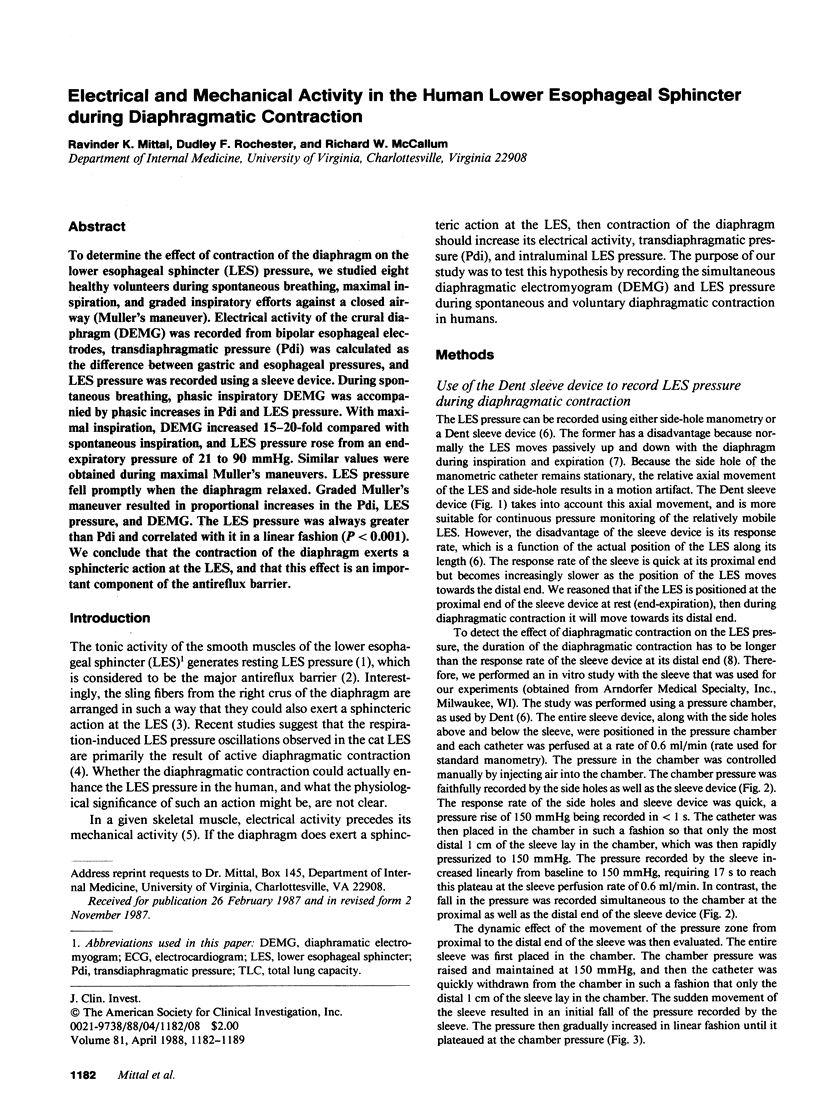
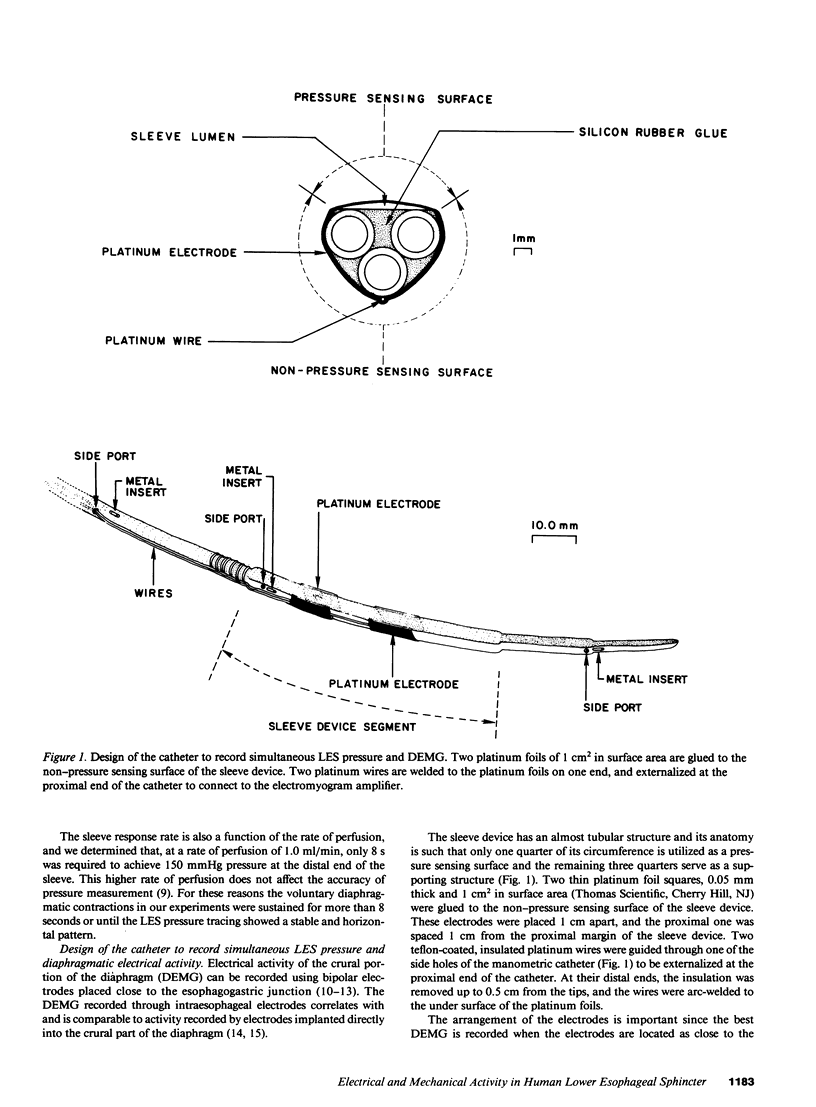
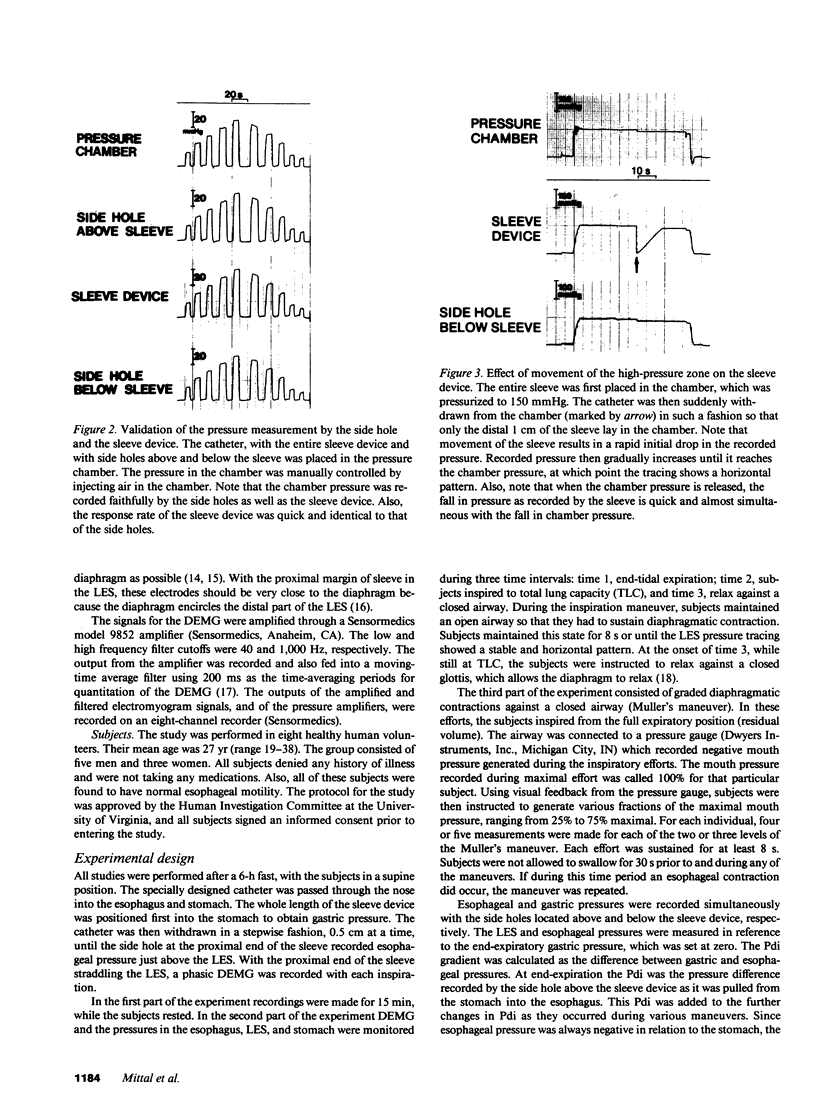
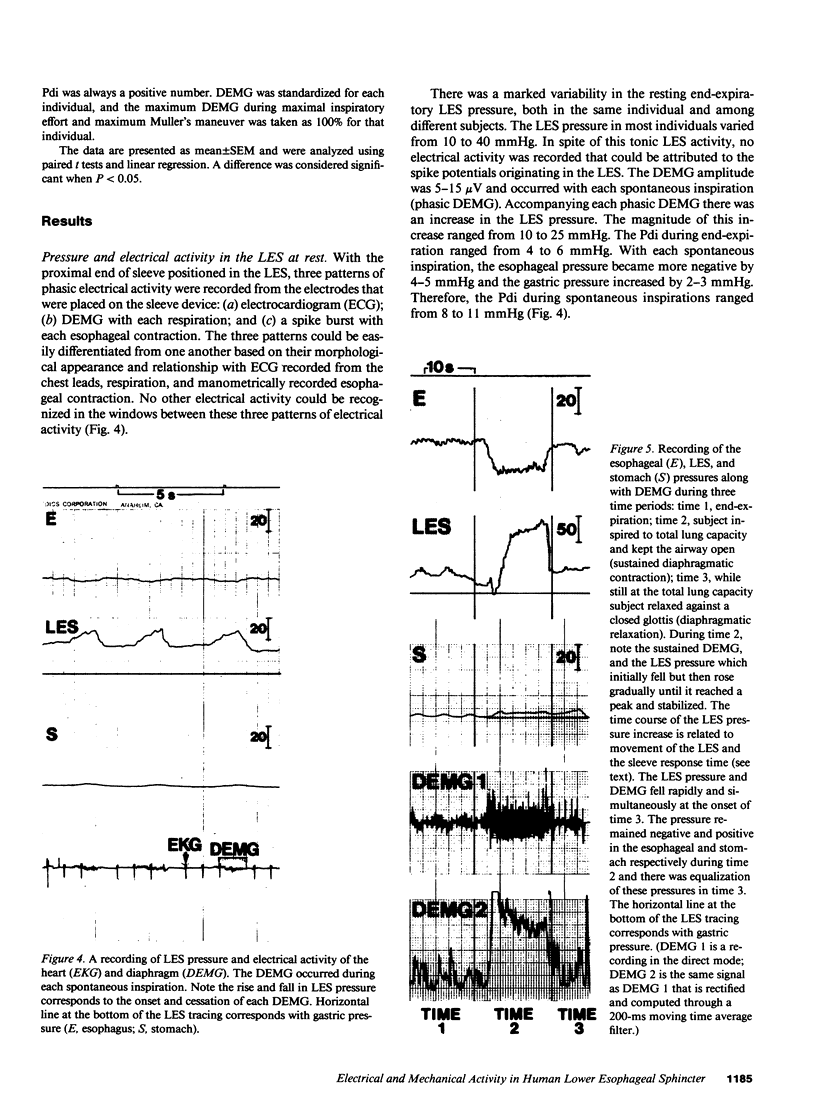
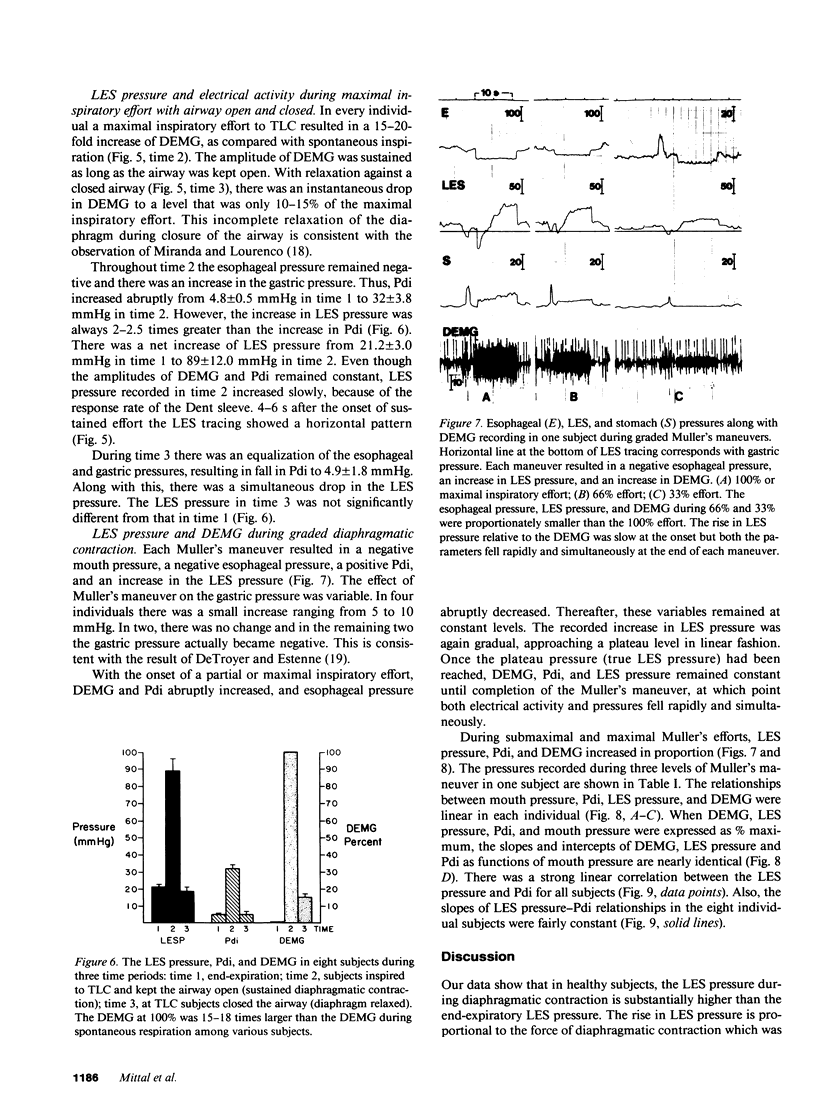
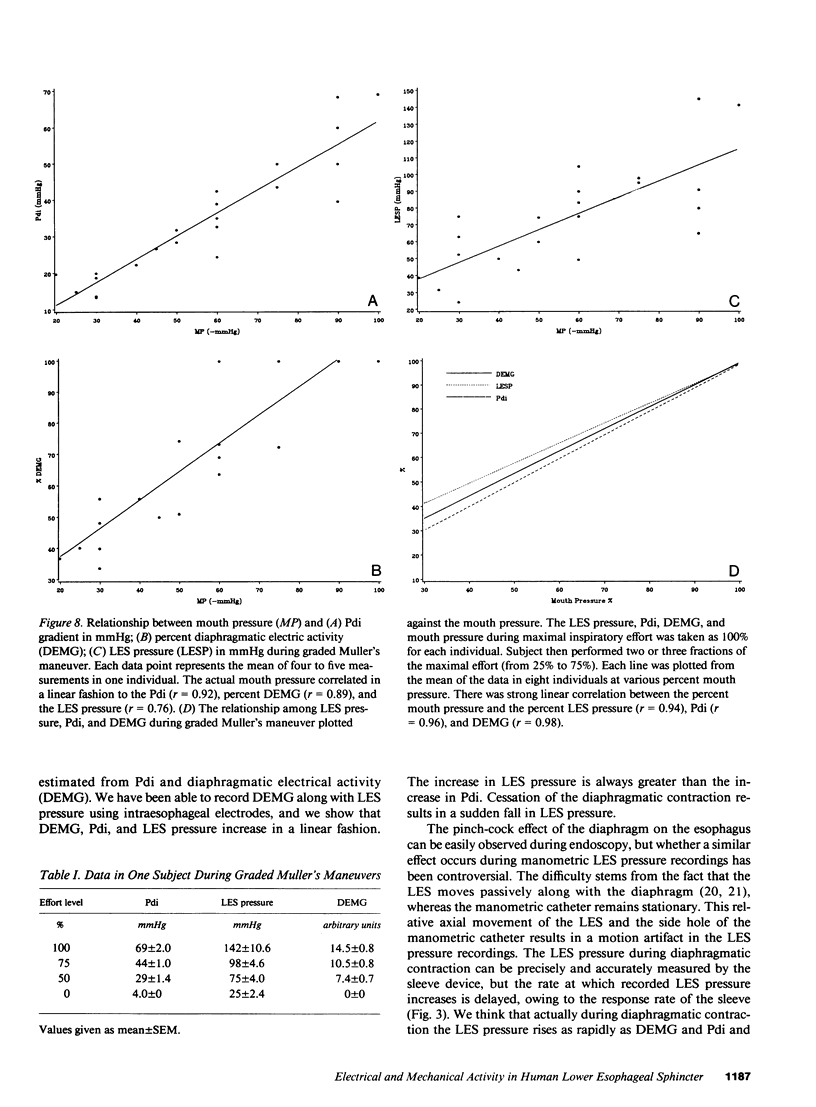


Selected References
These references are in PubMed. This may not be the complete list of references from this article.
- AGOSTONI E., SANT'AMBROGIO G., DEL PORTILLO CARRASCO H. Electromyography of the diaphragm in man and transdiaphragmatic pressure. J Appl Physiol. 1960 Nov;15:1093–1097. doi: 10.1152/jappl.1960.15.6.1093. [DOI] [PubMed] [Google Scholar]
- Asoh R., Goyal R. K. Electrical activity of the opossum lower esophageal sphincter in vivo. Its role in the basal sphincter pressure. Gastroenterology. 1978 May;74(5 Pt 1):835–840. [PubMed] [Google Scholar]
- Bellemare F., Bigland-Ritchie B., Woods J. J. Contractile properties of the human diaphragm in vivo. J Appl Physiol (1985) 1986 Sep;61(3):1153–1161. doi: 10.1152/jappl.1986.61.3.1153. [DOI] [PubMed] [Google Scholar]
- Bishop B., Settle S., Hirsch J. Single motor unit activity in the diaphragm of cat during pressure breathing. J Appl Physiol Respir Environ Exerc Physiol. 1981 Feb;50(2):348–357. doi: 10.1152/jappl.1981.50.2.348. [DOI] [PubMed] [Google Scholar]
- Boyle J. T., Altschuler S. M., Nixon T. E., Tuchman D. N., Pack A. I., Cohen S. Role of the diaphragm in the genesis of lower esophageal sphincter pressure in the cat. Gastroenterology. 1985 Mar;88(3):723–730. doi: 10.1016/0016-5085(85)90143-x. [DOI] [PubMed] [Google Scholar]
- DRAPER M. H., LADEFOGED P., WHITTERIDGE D. Respiratory muscles in speech. J Speech Hear Res. 1959 Mar;2(1):16–27. doi: 10.1044/jshr.0201.16. [DOI] [PubMed] [Google Scholar]
- De Troyer A., Estenne M. Limitations of measurement of transdiaphragmatic pressure in detecting diaphragmatic weakness. Thorax. 1981 Mar;36(3):169–174. doi: 10.1136/thx.36.3.169. [DOI] [PMC free article] [PubMed] [Google Scholar]
- Dent J. A new technique for continuous sphincter pressure measurement. Gastroenterology. 1976 Aug;71(2):263–267. [PubMed] [Google Scholar]
- Dent J., Dodds W. J., Friedman R. H., Sekiguchi T., Hogan W. J., Arndorfer R. C., Petrie D. J. Mechanism of gastroesophageal reflux in recumbent asymptomatic human subjects. J Clin Invest. 1980 Feb;65(2):256–267. doi: 10.1172/JCI109667. [DOI] [PMC free article] [PubMed] [Google Scholar]
- Dodds W. J., Dent J., Hogan W. J., Helm J. F., Hauser R., Patel G. K., Egide M. S. Mechanisms of gastroesophageal reflux in patients with reflux esophagitis. N Engl J Med. 1982 Dec 16;307(25):1547–1552. doi: 10.1056/NEJM198212163072503. [DOI] [PubMed] [Google Scholar]
- Dodds W. J., Stef J. J., Hogan W. J. Factors determining pressure measurement accuracy by intraluminal esophageal manometry. Gastroenterology. 1976 Jan;70(1):117–123. [PubMed] [Google Scholar]
- Dodds W. J., Stewart E. T., Hodges D., Zboralske F. F. Movement of the feline esophagus associated with respiration and peristalsis. An evaluation using tantalum markers. J Clin Invest. 1973 Jan;52(1):1–13. doi: 10.1172/JCI107152. [DOI] [PMC free article] [PubMed] [Google Scholar]
- Dodds W. J., Stewart E. T., Hogan W. J., Stef J. J., Arndorfer R. C. Effect of esophageal movement on intraluminal esophageal pressure recording. Gastroenterology. 1974 Oct;67(4):592–600. [PubMed] [Google Scholar]
- Goyal R. K., Rattan S. Genesis of basal sphincter pressure: effect of tetrodotoxin on lower esophageal sphincter pressure in opossum in vivo. Gastroenterology. 1976 Jul;71(1):62–67. [PubMed] [Google Scholar]
- Grassino A. E., Whitelaw W. A., Milic-Emili J. Influence of lung volume and electrode position on electromyography of the diaphragm. J Appl Physiol. 1976 Jun;40(6):971–975. doi: 10.1152/jappl.1976.40.6.971. [DOI] [PubMed] [Google Scholar]
- Hill A. R., Kaiser D. L., Rochester D. F. Effects of thoracic volume and shape on electromechanical coupling in abdominal muscles. J Appl Physiol Respir Environ Exerc Physiol. 1984 May;56(5):1294–1301. doi: 10.1152/jappl.1984.56.5.1294. [DOI] [PubMed] [Google Scholar]
- Kim M. J., Druz W. S., Danon J., Machnach W., Sharp J. T. Effects of lung volume and electrode position on the esophageal diaphragmatic EMG. J Appl Physiol Respir Environ Exerc Physiol. 1978 Sep;45(3):392–398. doi: 10.1152/jappl.1978.45.3.392. [DOI] [PubMed] [Google Scholar]
- Linehan J. H., Dent J., Dodds W. J., Hogan W. J. Sleeve device functions as a Starling resistor to record sphincter pressure. Am J Physiol. 1985 Feb;248(2 Pt 1):G251–G255. doi: 10.1152/ajpgi.1985.248.2.G251. [DOI] [PubMed] [Google Scholar]
- Lourenço R. V., Cherniack N. S., Malm J. R., Fishman A. P. Nervous output from the respiratory center during obstructed breathing. J Appl Physiol. 1966 Mar;21(2):527–533. doi: 10.1152/jappl.1966.21.2.527. [DOI] [PubMed] [Google Scholar]
- Miranda J. M., Lourenço R. V. Influence of diaphragm activity on the measurement of total chest compliance. J Appl Physiol. 1968 Jun;24(6):741–746. doi: 10.1152/jappl.1968.24.6.741. [DOI] [PubMed] [Google Scholar]
- PETIT J. M., MILIC-EMILI G., DELHEZ L. Role of the diaphragm in breathing in conscious normal man: an electromyographic study. J Appl Physiol. 1960 Nov;15:1101–1106. doi: 10.1152/jappl.1960.15.6.1101. [DOI] [PubMed] [Google Scholar]
- Richter J. E., Castell D. O. Gastroesophageal reflux. Pathogenesis, diagnosis, and therapy. Ann Intern Med. 1982 Jul;97(1):93–103. doi: 10.7326/0003-4819-97-1-93. [DOI] [PubMed] [Google Scholar]
- Schweitzer T. W., Fitzgerald J. W., Bowden J. A., Lynne-Davies P. Spectral analysis of human inspiratory diaphragmatic electromyograms. J Appl Physiol Respir Environ Exerc Physiol. 1979 Jan;46(1):152–165. doi: 10.1152/jappl.1979.46.1.152. [DOI] [PubMed] [Google Scholar]
- Welch R. W., Gray J. E. Influence of respiration on recordings of lower esophageal sphincter pressure in humans. Gastroenterology. 1982 Sep;83(3):590–594. [PubMed] [Google Scholar]
- Winans C. S. Alteration of lower esophageal sphincter characteristics with respiration and proximal esophageal balloon distention. Gastroenterology. 1972 Mar;62(3):380–388. [PubMed] [Google Scholar]


